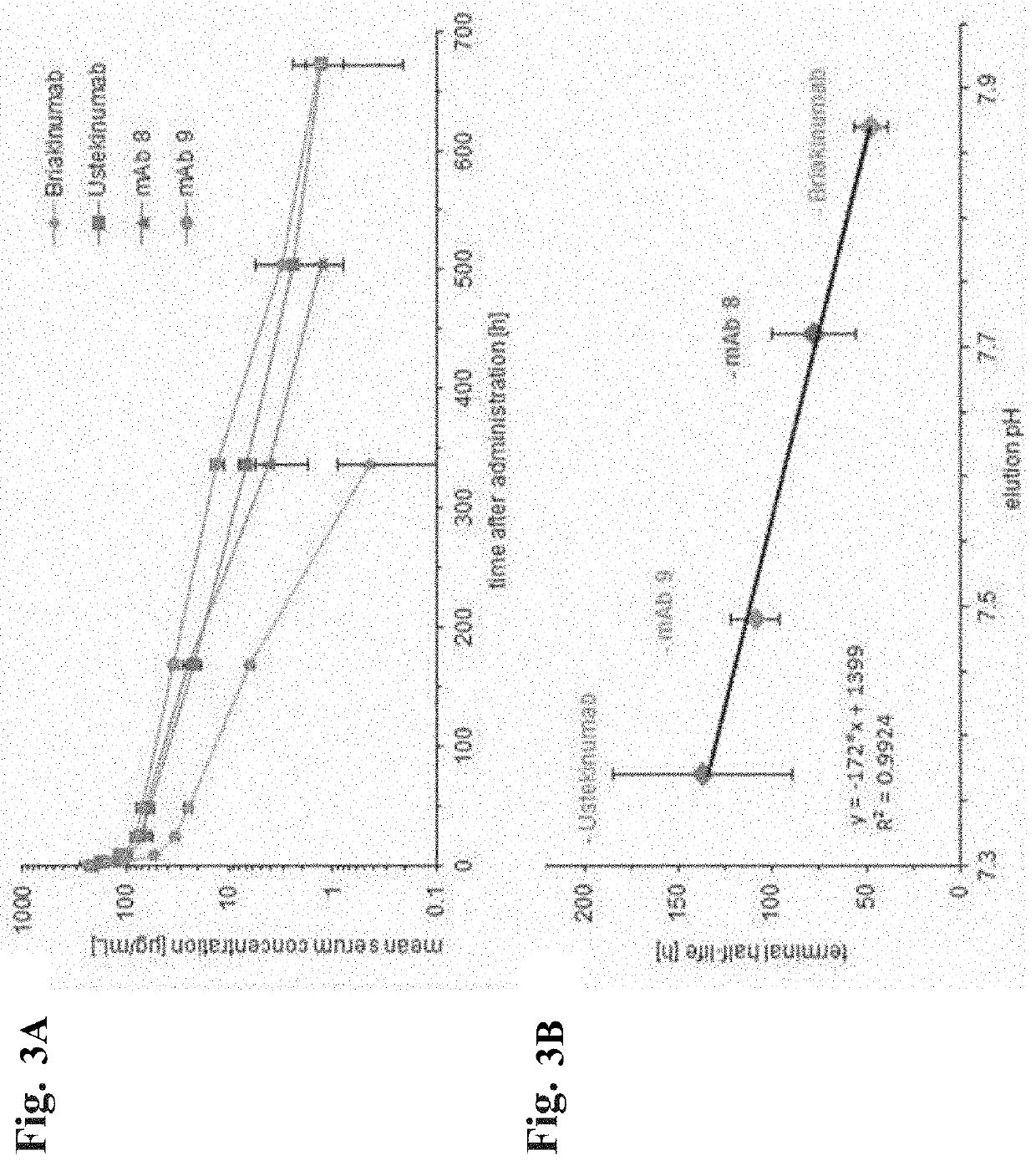Vitro prediction of in vivo half-life
a technology of in vivo half-life and antibody, applied in the field of recombinant antibody technology, can solve the problems of underlying mechanism how the fab region influences fcrn binding, which is still unelucidated, and achieve the effect of reducing the fcrn-dependent terminal half-life of the antibody and changing the binding characteristics of fcrn
- Summary
- Abstract
- Description
- Claims
- Application Information
AI Technical Summary
Benefits of technology
Problems solved by technology
Method used
Image
Examples
specific embodiments
[0370]1. A method for selecting an antibody comprising the following steps:[0371]i) determining a first retention time of the antibody and a reference antibody on an FcRn affinity chromatography column with a positive linear pH gradient elution in the presence of a first salt concentration, and determining a second retention time of the antibody and the reference antibody on an FcRn affinity chromatography column with the positive linear pH gradient elution in the presence of a second salt concentration, or[0372]ii) determining a first retention time of the antibody and a reference antibody on an FcRn affinity chromatography column with a linear salt gradient elution at a first pH value, and determining a second retention time of the antibody and the reference antibody on an FcRn affinity chromatography column with the linear salt gradient elution at a second pH value, or[0373]iii) determining for the antibody and a reference antibody the KD value at pH 6 using surface plasmon reson...
example 1
Preparation of FcRn Affinity Column
Expression of FcRn in HEK293 Cells
[0600]FcRn was transiently expressed by transfection of HEK293 cells with two plasmids containing the coding sequence of FcRn and of beta-2-microglobulin. The transfected cells were cultured in shaker flasks at 36.5° C., 120 rpm (shaker amplitude 5 cm), 80% humidity and 7% CO2. The cells were diluted every 2-3 days to a density of 3 to 4*105 cells / ml.
[0601]For transient expression, a 141 stainless steel bioreactor was started with a culture volume of 8 l at 36.5° C., pH 7.0±0.2, pO2 35% (gassing with N2 and air, total gas flow 200 ml min−1) and a stirrer speed of 100-400 rpm. When the cell density reached 20*105 cells / ml, 10 mg plasmid DNA (equimolar amounts of both plasmids) was diluted in 400 ml Opti-MEM (Invitrogen). 20 ml of 293fectin (Invitrogen) was added to this mixture, which was then incubated for 15 minutes at room temperature and subsequently transferred into the fermenter. From the next day on, the cell...
example 2
Chromatography Using the FcRn Affinity Column and pH Gradient
[0605]The receptor derivatized sepharose was filled in a 1 ml XK column (GE Healthcare) and the FcRn column then was equilibrated with 20 mM 2-(N-morpholine)-ethanesulfonic acid (MES) buffer containing 140 mM NaCl, pH 5.5.
Conditions:
[0606]column dimensions: 50 mm×5 mm[0607]bed height: 5 cm[0608]loading: 30 μg sample[0609]equilibration buffer: 20 mM MES, with 140 mM NaCl, adjusted to pH 5.5[0610]elution buffer: 20 mM Tris / HCl, with 140 mM NaCl, adjusted to pH 8.8[0611]elution: 7.5 CV equilibration buffer, in 120 min. to 100% elution buffer, 10 CV elution buffer
[0612]The samples were prepared in 20 mM 2-(N-morpholine)-ethanesulfonic acid (MES) sodium salt, 140 mM sodium chloride, pH 5.5. Each sample contained 30 μg mAb per injection. Antibodies were eluted by a linear pH gradient from pH 5.5 to 8.8 within 120 minutes using 20 mM 2-(N-morpholine)-ethanesulfonic acid (MES) sodium salt, 140 mM sodium chloride, pH 5.5 and 20 mM ...
PUM
| Property | Measurement | Unit |
|---|---|---|
| pH | aaaaa | aaaaa |
| pH | aaaaa | aaaaa |
| pH | aaaaa | aaaaa |
Abstract
Description
Claims
Application Information
 Login to View More
Login to View More - R&D
- Intellectual Property
- Life Sciences
- Materials
- Tech Scout
- Unparalleled Data Quality
- Higher Quality Content
- 60% Fewer Hallucinations
Browse by: Latest US Patents, China's latest patents, Technical Efficacy Thesaurus, Application Domain, Technology Topic, Popular Technical Reports.
© 2025 PatSnap. All rights reserved.Legal|Privacy policy|Modern Slavery Act Transparency Statement|Sitemap|About US| Contact US: help@patsnap.com



